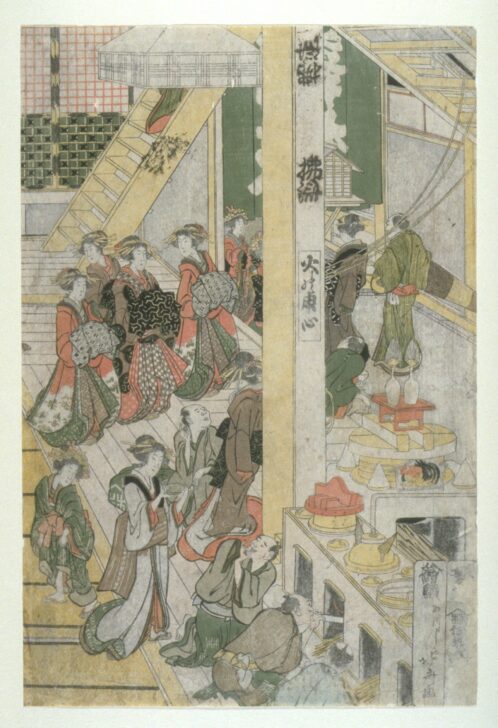Grand Interior View of a Courtesan House in the Yoshiwara District (Yoshiwara o-magaki no zu, one of pentaptych)
Katsushika Hokusai

Description
Gallery Rotation Fall 2013
Katsushika Hokusai
Japan, 1760–1849
Grand Interior View of a
Courtesan House in the
Yoshiwara District
Edo period (1615–1868)
circa 1811–13
Color woodblock print on paper
Museum purchase, 1938.1–3
These three prints belong to a series of five showing the interior of a bustling brothel in Yoshiwara, the licensed red-light district in Edo (modern day Tokyo). The space is filled with ostentatiously dressed courtesans, with a plethora of hair accessories, gorgeous robes, and obi (sash). In between the courtesans and their young attendants (kamuro), male and female servants are busy with their chores, as if the brothel were soon to open to customers. Interior elements such as sliding doors with intricate wood panels, impeccably clean tatami mats, and the luxurious painting of a phoenix in the back suggest that this brothel caters to sophisticated and wealthy clients.
These prints were produced in the early years of Hokusai’s long career. Although his brilliant design sense is not so much in evidence here, his meticulous attention to details is apparent: male servants blow air into the stove’s furnace while courtesans touch-up their make-up and female servants wipe dust off the footed trays.
Subject Matter:
A print showing the inside of a brothel in Yoshiwara. The finely dressed courtesans are walking around while young attendants are busy with chores, such as one man blowing air into a furnace, as if the brothel is about to open. The clean state of the brothel implies that it caters to sophisticated and wealthy clients. This print is part of a series of five.;This scene in rural England was one of two images that Whistler contributed to the volume "Passages from Modern English Poets," published in 1862. The other work by Whistler among the 47 etchings in the book was "Sketching No. 1".
Physical Description:
A large group of young women inside a building surrounded by male servants. The women all wear various styles of kimono, though the predominant colors are red and green. The inside of the building is on the bottom floor with a set of steps leading up to a second floor, not depicted.;In a tranquil pastoral setting, a man stands in a punt (or shallow-bottomed open boat) with a pipe in his mouth and holding a pole to help propel himself through the shallow river.
Usage Rights:
If you are interested in using an image for a publication, please visit https://umma.umich.edu/request-image/ for more information and to fill out the online Image Rights and Reproductions Request Form.